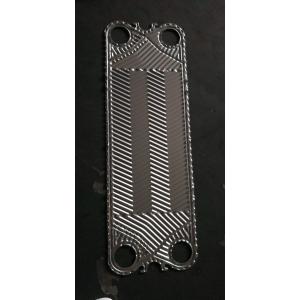
Add to Cart
Product Description
Extensive Selection Of Plate And Gasket Materials For Heat Exchangers, Stainless Steel SUS304, SUS316L, Titanium
Quality control processing for the plate in PHE
Plate Heat Exchangers (PHE)require rigorous quality controlprocedures to guarantee theirefficiency and dependability. Thefollowing are essential qualitycontrol measures for PHE plates.
Material Inspection: Thoroughly examine the plate material to confirm its quality and adherence to corrosionresistance, thermal conductivity,and strength standards.
Dimensional Accuracy: Verifythat the plate dimensions align with design specifications and to lerances, ensuring a proper fitand alignment within the heatexchanger.
Surface Finish Inspection: Carefully assess the plate surface finish to guarantee its smoothness and absence ofdefects that may hinder heat transfer efficiency.
Pressure Testing: Perform pressure tests on the plates to validate the ircapacity to endure operational pressure without deformations or leaks.
Welding Quality: lf the platesare welded together, inspect the welding quality to ensureproper bonding and the integrity of the welded joints.
Heat Transfer Performance Testing: Evaluate the heat transfer performance of theplates by conducting tests that measure their thermaconductivity and efficiency intransferring heat between fluids.
Corrosion Resistance Testing: Test the plates for corrosionresistance to ensure they can withstand exposure to corrosive fluids and environments.
By implementing these quality control processes for the plates in a PHE, manufacturers can ensure that the heat exchanger operates effectively, efficiently, and reliably in various applications.
ACCESSEN Series Heat Exchanger Plates:
When aiming to design an efficient heat exchanger, critical attention must be given to the selection of the plate shape, size, and material. Here are key considerations to keep in mind when choosing the shape, size, and material of a heat exchanger plate:
1. Plate Shape : The chosen plate shape should be suitable for the specific application requirements and operational conditions. Proper shape selection can enhance heat exchange efficiency and optimize fluid flow.
2. Plate Size : Select the plate size based on the required surface area for efficient heat exchange. Proper sizing ensures optimal performance of the heat exchanger.
3. Plate Material : The material choice for the plate is crucial to ensure long-term reliability, corrosion resistance, and overall performance. It is important to select a material that is compatible with the processed fluid and the operational conditions.
4. Operational Conditions :
Consider factors such as temperature, pressure, fluid type, and other operational conditions when selecting the plate shape, size, and material. This evaluation helps determine the most suitable plate for the specific application.
5. Cost and Efficiency : Evaluate the cost of manufacturing, installing, and maintaining the plate heat exchanger in relation to the desired efficiency. Choose a combination of plate shapes, sizes, and materials that provides the optimal balance between performance and cost.
Considering these factors will enable you to make an informed decision when selecting the heat exchanger plate shape, size, and material, ensuring optimal performance according to your specific application needs.
| Brand | Model |
|
ACCESSEN |
AU3,AU5,AS6,AU8,AU10L1,AU10L2,AU15L1,AU15L2,AU15M,AU20, AU20M,AN5,AN10L1,AN10L2,AN10M,AN15L1,AN15L2,AU25L1, AU25L3,AN20,AN25L1,AN25L2,AN30L1,AN30L2,AN30L3,AN30L, AN35L1,AN35L2,,AN35L3,AN35L4,AN40L1,AN40L2,AN40L3,AN40L4 AN45L1,AN45L2,AN45L3,AN45L4,AS20,AS25,AC190,AC230,AP20, AP25,AP35 |
| Material | Specification |
| Stainless Steel |
SUS304 316 316L 310S 904 |
| Titanium and titanium-palladium alloy | TAi TAi-Pd |
| Hastelloy |
C276 D205 B2G |
| Nickel | Ni200 Ni201 |
| Molybdenum | 254 |
Applacations
Products are mainly suitable for ACCESSEN/GEA (Kelvion)/ APV/ Sondex/ Tranter/ Hisaka/ API/ Funke/ Vicarb/ Mueller/ SWEP/ Fischer/ AGC/ Thermalwave/ ITT/ LHE/ DHP, etc.
| Plate material | Suitable for fluids |
| Stainless steel (SUS304.316, etc.) | Purified water, river water, edible oil, mineral oil |
| Titanium and titanium palladium (Ti, Ti-Pd) | Sea water, salt water, salt compounds |
| 20Cr,18Ni,6Mo(254SMO) | Dilute sulfuric acid, dilute salt aqueous solution, inorganic aqueous solution |
| Nickel (Ni) | High temperature, high concentration caustic soda |
| HASTELLOY alloy (C276, D205, B2G) | Concentrated sulfuric acid, hydrochloric acid, phosphoric acid |
Q&A:
1. Q: What specific requirements do you have for the replacement plate in your heat exchanger?
A: By understanding your specific requirements, we can tailor the replacement plate to meet your exact needs.
2. Q: Are there any special materials or coatings you prefer for the replacement plate?
A: By offering a range of materials and coatings options, we can customize the replacement plate to suit your preferences.
3. Q: Do you have any size or design preferences for the replacement plate?
A: We can customize the size and design of the replacement plate to fit your heat exchanger perfectly.
4. Q: Would you like any additional features or modifications incorporated into the replacement plate?
A: We can discuss adding any additional features or modifications to enhance the performance of the replacement plate.
5. Q: How can we assist you further in ensuring that the replacement plate meets your specific requirements and expectations?
A: We are committed to providing personalized service and support throughout the replacement process to ensure your complete satisfaction.



